
Wrenbury
Encyclopedia
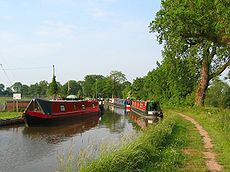
Village
A village is a clustered human settlement or community, larger than a hamlet with the population ranging from a few hundred to a few thousand , Though often located in rural areas, the term urban village is also applied to certain urban neighbourhoods, such as the West Village in Manhattan, New...
in the civil parish of Wrenbury cum Frith, the unitary authority of Cheshire East
Cheshire East
Cheshire East is a unitary authority area with borough status in the ceremonial county of Cheshire, England.The borough was established in April 2009 as part of the 2009 structural changes to local government in England, by virtue of an order under the Local Government and Public Involvement in...
, and the ceremonial county of Cheshire
Cheshire
Cheshire is a ceremonial county in North West England. Cheshire's county town is the city of Chester, although its largest town is Warrington. Other major towns include Widnes, Congleton, Crewe, Ellesmere Port, Runcorn, Macclesfield, Winsford, Northwich, and Wilmslow...
, England. It lies on the River Weaver
River Weaver
The River Weaver is a river, navigable in its lower reaches, running in a curving route anti-clockwise across west Cheshire, northern England. Improvements to the river to make it navigable were authorised in 1720 and the work, which included eleven locks, was completed in 1732...
, around 8.5 miles south-west of Crewe
Crewe
Crewe is a railway town within the unitary authority area of Cheshire East and the ceremonial county of Cheshire, England. According to the 2001 census the urban area had a population of 67,683...
.
The civil parish of Wrenbury cum Frith covers the village of Wrenbury and the small settlements of Gaunton's Bank, Pinsley Green, Porter's Hill, Smeaton Wood, Wrenbury Heath and Wrenburywood. It has a total population of around 1,100.
History
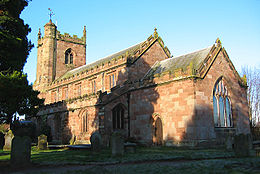
Domesday Book
Domesday Book , now held at The National Archives, Kew, Richmond upon Thames in South West London, is the record of the great survey of much of England and parts of Wales completed in 1086...
as Wareneberie, and became Wrennebury in 1230. The name is said to mean "old forest inhabited by wrens". Wrenbury formed part of the extensive lands of William Malbank (also William Malbedeng), who owned much of the Nantwich hundred.
As a chapel attached to St Mary's Church, Acton
St Mary's Church, Acton
St Mary's Church, Acton is an active Anglican church in Acton, a village to the west of Nantwich, Cheshire, England. It has been designated by English Heritage as a Grade I listed building. A church has been present on this site since before the time of the Domesday Survey. The tower is the...
, Wrenbury was included in the lands donated to the Cistercian Combermere Abbey
Combermere Abbey
Combermere Abbey is a former monastery in Combermere Park, between Nantwich and Whitchurch in Cheshire, England, near the border with Shropshire.-Topomony:...
in around 1180, shortly after the abbey's 1133 foundation by Hugh Malbank, second Baron of Nantwich. In 1539, after the Dissolution
Dissolution of the Monasteries
The Dissolution of the Monasteries, sometimes referred to as the Suppression of the Monasteries, was the set of administrative and legal processes between 1536 and 1541 by which Henry VIII disbanded monasteries, priories, convents and friaries in England, Wales and Ireland; appropriated their...
, the land was granted to George Cotton, and the Cotton family remained important local landowners for centuries.
A free school by the church was endowed by Ralph Buckley in 1605.
Governance
Wrenbury cum Frith is administered by the Wrenbury-cum-Frith parish council. From 1974 the civil parish was served by Crewe and NantwichCrewe and Nantwich
Crewe and Nantwich was, from 1974 to 2009, a local government district with borough status in Cheshire, England. It had a population of 111,007...
Borough Council, which was succeeded on 1 April 2009 by the new unitary authority
Unitary authority
A unitary authority is a type of local authority that has a single tier and is responsible for all local government functions within its area or performs additional functions which elsewhere in the relevant country are usually performed by national government or a higher level of sub-national...
of Cheshire East
Cheshire East
Cheshire East is a unitary authority area with borough status in the ceremonial county of Cheshire, England.The borough was established in April 2009 as part of the 2009 structural changes to local government in England, by virtue of an order under the Local Government and Public Involvement in...
. Wrenbury cum Frith falls in the parliamentary constituency of Eddisbury
Eddisbury (UK Parliament constituency)
Eddisbury is a county constituency represented in the House of Commons of the Parliament of the United Kingdom. It elects one Member of Parliament by the first-past-the-post system of election.- Boundaries :...
, and has been represented by Stephen O'Brien since 1999.
Geography and transport
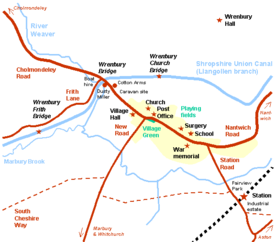
Nantwich
Nantwich is a market town and civil parish in the Borough of Cheshire East and the ceremonial county of Cheshire, England. The town gives its name to the parliamentary constituency of Crewe and Nantwich...
, Cheshire and five miles north-east of Whitchurch
Whitchurch, Shropshire
Whitchurch is a market town in Shropshire, England on the border between England and Wales. It is the oldest continuously inhabited town in Shropshire. According to the 2001 Census, the population of the town is 8,673, with a more recent estimate putting the population of the town at 8,934...
, Shropshire
Shropshire
Shropshire is a county in the West Midlands region of England. For Eurostat purposes, the county is a NUTS 3 region and is one of four counties or unitary districts that comprise the "Shropshire and Staffordshire" NUTS 2 region. It borders Wales to the west...
. Nearby villages include Marbury, Aston
Aston by Wrenbury
Aston is a village in the civil parish of Newhall in the unitary authority of Cheshire East and the ceremonial county of Cheshire, England.The village should not be confused with several other villages named Aston in Cheshire, which include Aston...
and Audlem
Audlem
Audlem is a large village and civil parish located in the unitary authority of Cheshire East and the ceremonial county of Cheshire in the north west of England, approximately south of Nantwich. Close to the border with the neighbouring county of Shropshire, the village is eight miles east of...
.
The village is on the Llangollen branch
Llangollen Canal
The Llangollen Canal is a navigable canal crossing the border between England and Wales. The waterway links Llangollen in Denbighshire, north Wales, with Hurleston in south Cheshire, via the town of Ellesmere, Shropshire....
of the Shropshire Union Canal
Shropshire Union Canal
The Shropshire Union Canal is a navigable canal in England; the Llangollen and Montgomery canals are the modern names of branches of the Shropshire Union system and lie partially in Wales....
. It has an unmanned station
Wrenbury railway station
Wrenbury railway station serves the village of Wrenbury in Cheshire, England and is on the Welsh Marches Line south east of Crewe. It is an unstaffed, request-stop station with two platforms.-Services:...
on the Welsh Marches Railway
Welsh Marches Line
The Welsh Marches Line , known historically as the North and West Route, is the railway line running from Newport in south-east Wales to Shrewsbury in the West Midlands region of England by way of Abergavenny, Hereford and Craven Arms, and thence to Crewe via Whitchurch...
. The Cheshire Cycleway runs through the village and the South Cheshire Way
South Cheshire Way
The South Cheshire Way is a long-distance footpath running east–west mainly through Cheshire, England, though parts lie in Shropshire and Staffordshire. The western section from Grindley Brook, near Whitchurch, runs through farmland; the eastern section from Mow Cop, near Biddulph, runs through...
long-distance path runs just south of it.
Demography
In 2006, the total population of the civil parish was estimated as 1,100. In the 2001 censusUnited Kingdom Census 2001
A nationwide census, known as Census 2001, was conducted in the United Kingdom on Sunday, 29 April 2001. This was the 20th UK Census and recorded a resident population of 58,789,194....
, the recorded population was 1060. The population has doubled since the beginning of the 20th century; the historical population figures were 404 in 1801, 490 in 1851, 491 in 1901 and 708 in 1951.
Places of worship
The red sandstone St Margaret's ChurchSt Margaret's Church, Wrenbury
St Margaret's Church, Wrenbury overlooks the village green of Wrenbury, Cheshire, England. The church has been designated by English Heritage as a Grade II* listed building. It is an active Anglican parish church in the diocese of Chester, the archdeaconry of Macclesfield and the deanery of...
, overlooking the village green, dates from the early 16th century. Notable features include a rare example of a dog whipper
Dog Whipper
A dog whipper was a church official charged with removing unruly dogs from a church or church grounds during services.In some areas of Europe during the 16th to 19th centuries it was not uncommon for household dogs to accompany - or at least follow - their owners to church services...
's pew and a memorial to Stapleton Cotton, 1st Viscount Combermere
Stapleton Cotton, 1st Viscount Combermere
Field Marshal Stapleton Cotton, 1st Viscount Combermere GCB, GCH, KSI, PC , was a British military leader, diplomat and politician...
. A war memorial
War memorial
A war memorial is a building, monument, statue or other edifice to celebrate a war or victory, or to commemorate those who died or were injured in war.-Historic usage:...
stands in the churchyard.
Other landmarks
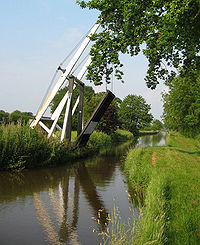
Conservation Area (United Kingdom)
In the United Kingdom, the term Conservation Area nearly always applies to an area considered worthy of preservation or enhancement because of its special architectural or historic interest, "the character or appearance of which it is desirable to preserve or enhance," as required by the Planning ...
. Two black-and-white cottages overlook the village green; Elm House is a Grade II listed cottage with prominent brick chimneys dating from the 17th century, while Stanley House dates from 1859. In the churchyard stands a small Grade II listed black-and-white cottage with brick infill, dating from the 17th century, which is possibly a former almshouse. Hawk House, formerly the Hawk and Buckle inn, is a Grade II listed brick cottage near the post office which dates from the early 18th century. There are also several black-and-white farmhouses and cottages within the Wrenbury cum Frith parish, some of which date from the 17th century.
Wrenbury Hall was the home of the Starkey family, prominent local landowners, until 1920; parts of the house date from the 17th century, although the front was refaced in Elizabethan style in 1916–19. It is said to have been used as shelter for the Parliamentary forces
Roundhead
"Roundhead" was the nickname given to the supporters of the Parliament during the English Civil War. Also known as Parliamentarians, they fought against King Charles I and his supporters, the Cavaliers , who claimed absolute power and the divine right of kings...
in 1643 when Nantwich was besieged before the Battle of Nantwich
Battle of Nantwich
The Battle of Nantwich was fought during the First English Civil War, between the forces of Parliament and of King Charles I, northwest of the town of Nantwich in Cheshire on 25 January 1644...
, during the Civil War
English Civil War
The English Civil War was a series of armed conflicts and political machinations between Parliamentarians and Royalists...
.
The Shropshire Union Canal near the village has three rare single-span timber lift bridges dating from 1790, which are among Thomas Telford
Thomas Telford
Thomas Telford FRS, FRSE was a Scottish civil engineer, architect and stonemason, and a noted road, bridge and canal builder.-Early career:...
's earliest works. They are of the drawbridge
Drawbridge
A drawbridge is a type of movable bridge typically associated with the entrance of a castle surrounded by a moat. The term is often used to describe all different types of movable bridges, like bascule bridges and lift bridges.-Castle drawbridges:...
type, with a wooden platform hinged at the north end which is raised and lowered by counterbalancing beam weights. Two are Grade II* listed footbridges; the Grade II listed third bridge now carries road traffic and incorporates a modern mechanical crank.
Education
The Grade II listed red-brick village primary school dates from 1879 and features a bellcote and weathervane. It won the "Champion School" category of the "Your Champions" Awards 2007, sponsored by Scottish PowerScottish Power
ScottishPower Ltd. is a vertically integrated energy company with its headquarters in Glasgow, Scotland. It was listed on the London Stock Exchange and was once a constituent of the FTSE 100 Index but in 2006 it became a subsidiary of the Spanish utility Iberdrola...
and Trinity Mirror
Trinity Mirror
Trinity Mirror plc is a large British newspaper and magazine publisher. It is Britain's biggest newspaper group, publishing 240 regional papers as well as the national Daily Mirror, Sunday Mirror and People, and the Scottish Sunday Mail and Daily Record. Its headquarters are at Canary Wharf in...
.
Culture and community
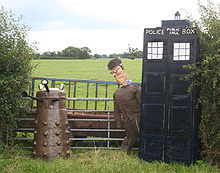
Bookmobile
A bookmobile or mobile library is a large vehicle designed for use as a library. It is designed to hold books on shelves so that when the vehicle is parked the books can be accessed by readers. It usually has enough space for people to sit and read books inside. Mobile libraries are often used to...
service visits Wrenbury and Wrenbury Heath fortnightly.
The village has two public houses, both of which serve food. The Cotton Arms, named for the Cotton family, is on Cholmondeley Road near the canal. The Dusty Miller occupies a 19th-century corn mill by the canal at Wrenbury Bridge, and is listed in The Good Pub Guide. Facilities for tourists include a caravan site near the canal and the Alvechurch Boat Centre, a boat hire company, which operates from Wrenbury Mill, beside Wrenbury Bridge.
Wrenbury is known for its annual scarecrow
Scarecrow
A scarecrow is, essentially, a decoy, though traditionally, a human figure dressed in old clothes and placed in fields by farmers to discourage birds such as crows or sparrows from disturbing and feeding on recently cast seed and growing crops.-History:In Kojiki, the oldest surviving book in Japan...
trail, which started in 2000. Held the first weekend in July as part of a Summer Fayre, around a hundred and fifty scarecrows were on display in 2006.
Notable residents
The Very Reverend Alan Brunskill WebsterAlan Brunskill Webster
Alan Brunskill WebsterKCVO was an Anglican priest and dean.Webster's father, the Reverend John Webster, was the vicar of St Margaret's Church in Wrenbury, Cheshire, where he lived until 1935...
(1918–2007), author and Dean of the cathedrals of Norwich
Norwich Cathedral
Norwich Cathedral is a cathedral located in Norwich, Norfolk, dedicated to the Holy and Undivided Trinity. Formerly a Catholic church, it has belonged to the Church of England since the English Reformation....
and St Paul's
St Paul's Cathedral
St Paul's Cathedral, London, is a Church of England cathedral and seat of the Bishop of London. Its dedication to Paul the Apostle dates back to the original church on this site, founded in AD 604. St Paul's sits at the top of Ludgate Hill, the highest point in the City of London, and is the mother...
, was born in Wrenbury. The son of John Webster, vicar of St Margaret's Church, he lived at the vicarage until 1935.

